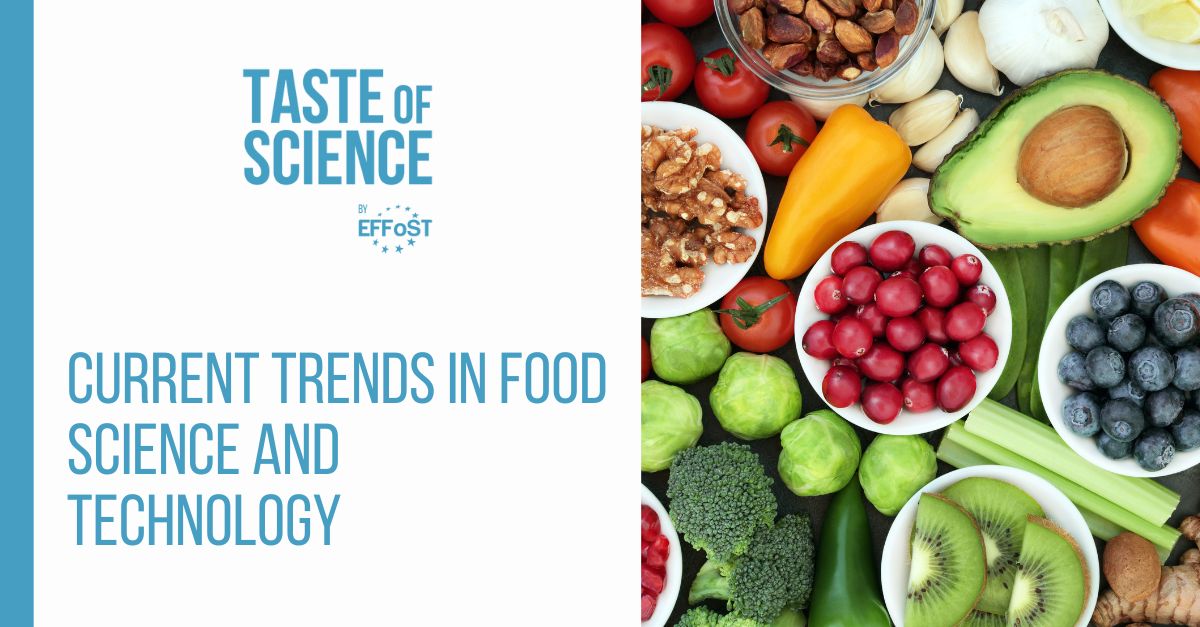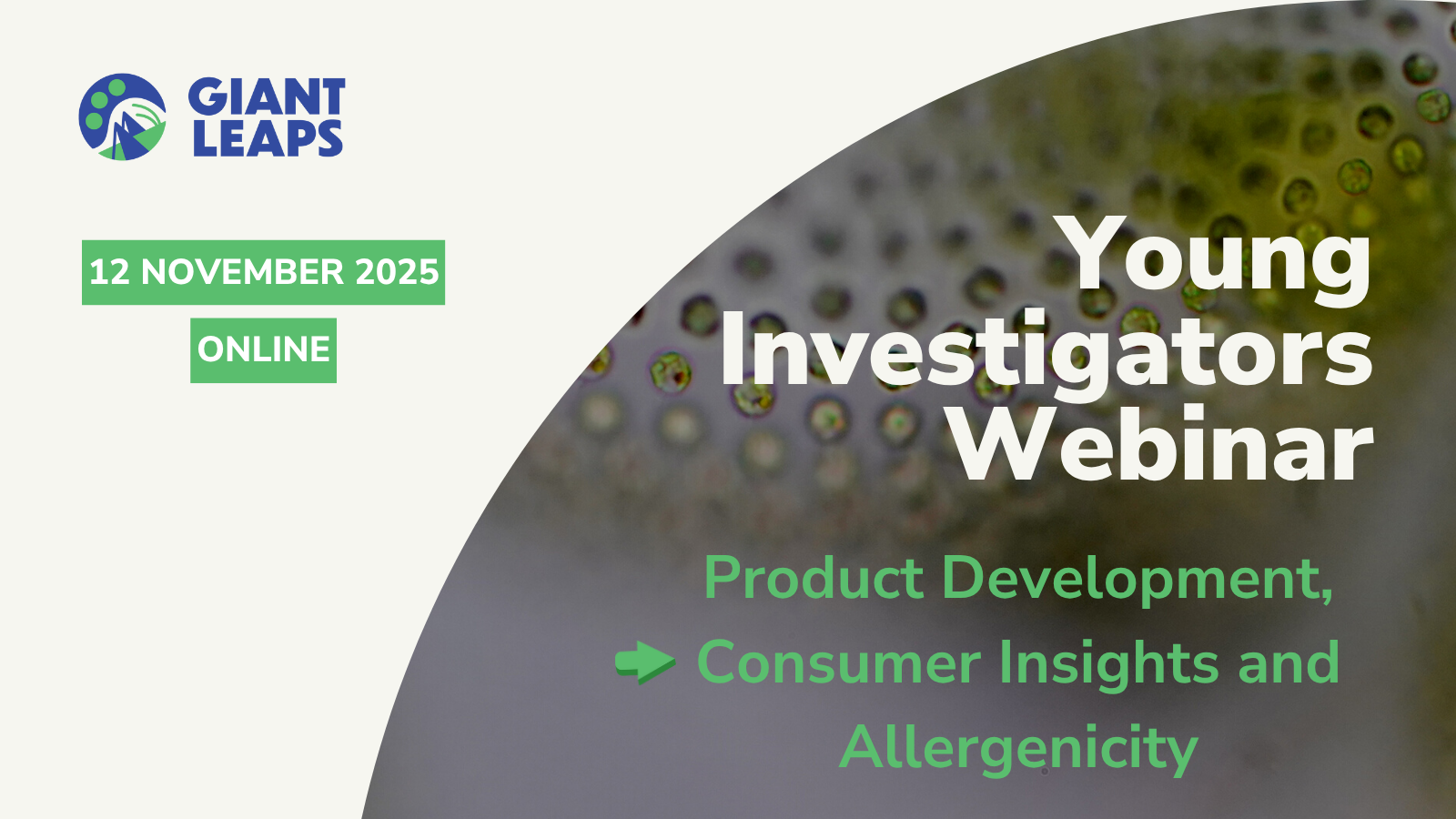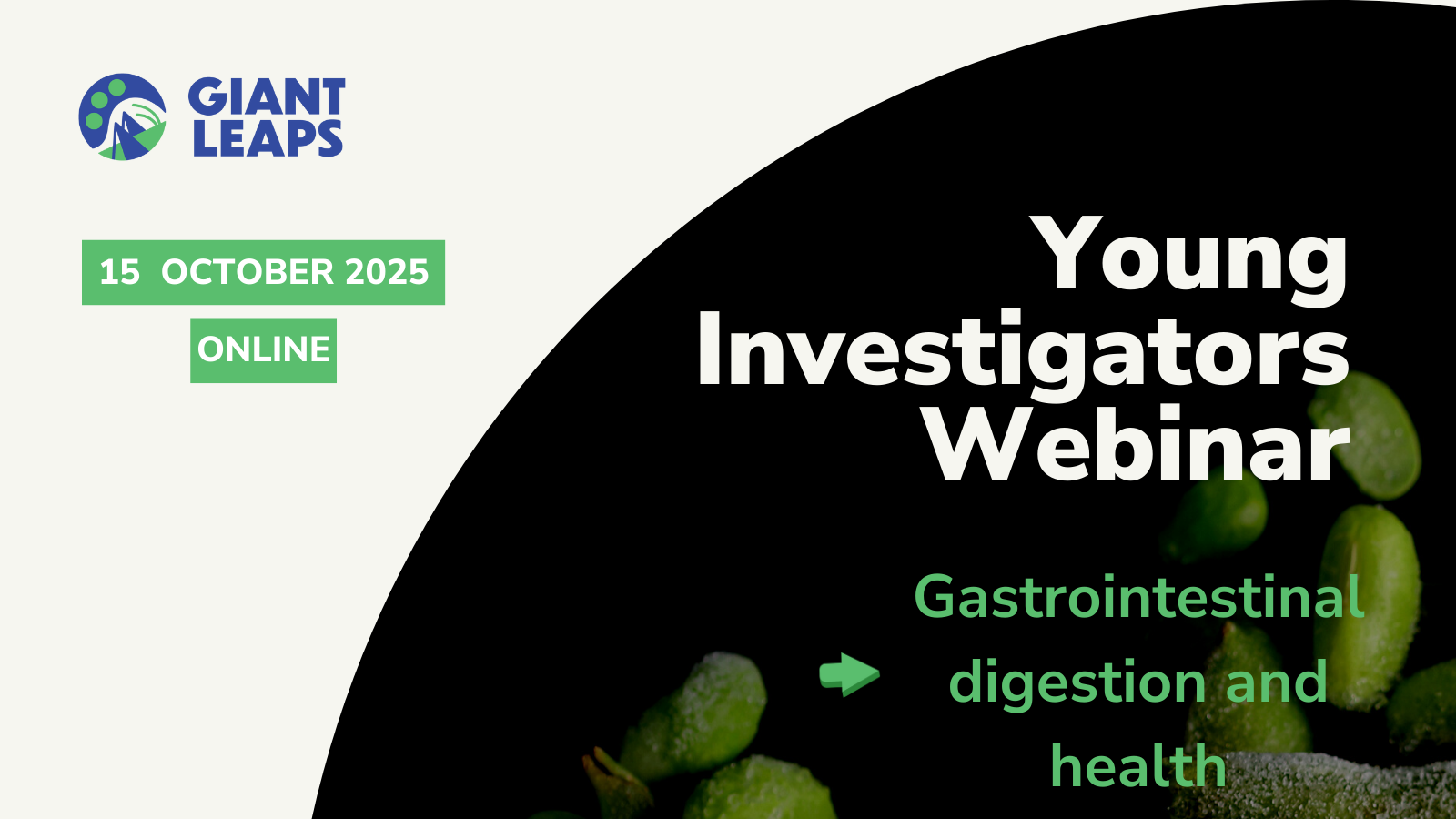Giant Leaps in the latest Taste of Science article "Current trends in food science and technology"

Article written by Lucian Miron and p
The global food system is evolving to address sustainability, health, and transparency
challenges. Climate change, resource depletion, and shifting consumer demands are driving innovations in alternative
proteins, food traceability, personalized nutrition, sustainable packaging, regenerative agriculture, and
digitalization.
Technological advancements and policy initiatives play a crucial role in shaping this transformation. EU-funded projects
like GIANT LEAPS, TITAN, CATALYSE, FoodDataQuest, and Data4Food2030 are driving research, regulatory alignment, and
market adoption of sustainable food solutions. These initiatives foster collaboration between scientists, policymakers,
and industry leaders, ensuring that innovations in food science align with environmental goals and consumer needs.
This article explores the latest trends and their potential to create a more resilient, efficient, and responsible food
system.
Alternative proteins
With the rising demand for sustainable food production, alternative proteins have emerged as a promising solution. These include plant-based proteins, insect-based sources, microbial fermentation-derived proteins, and cultured meat. Compared to conventional livestock farming, alternative proteins require significantly less land, water, and energy, contributing to a lower carbon footprint and reduced deforestation. However, major challenges still hinder their widespread adoption:
- Taste and texture – Consumers often find plant-based and cultured meat alternatives lacking in sensory appeal.
- Nutritional value – Some alternatives lack essential nutrients like vitamin B12 and complete amino acid profiles.
- Cost and scalability – Cultivated meat and fermentation-based proteins remain expensive to produce.
- Regulation and consumer perception – Many governments lack clear policies for labeling and approving novel proteins1.
Innovation and market trends
Technologies such as precision fermentation (used to produce dairy and meat proteins like casein and heme) and cellular agriculture (culturing animal cells for meat production) are revolutionizing protein alternatives. Emerging protein sources like algae, seaweed, and duckweed offer high nutritional value and sustainability benefits1.
The EU project GIANT LEAPS2 is accelerating the development and adoption of alternative proteins by bringing together scientists, policymakers, and industry leaders. It provides critical insights into safety, sustainability, and consumer acceptance, helping shape policies that support the protein transition.
Enhancing traceability and transparency
Food safety, authenticity, and ethical sourcing are increasingly important for consumers, businesses, and regulators. Ensuring transparent supply chains helps prevent food fraud, contamination, and unethical practices, improving trust and compliance3.
Key technologies driving traceability
- Blockchain – Secures unalterable food records for transparency.
- IoT sensors – Track storage and transport conditions in real time.
- AI & Big Data – Optimize logistics and predict contamination risks.
- DNA & Isotope Testing – Authenticate food origins and prevent mislabeling4.
Regulatory and market trends
Governments are implementing stricter regulations to enhance food traceability. The EU’s Digital Product Passport mandates detailed tracking of food origins and production processes.
The TITAN5 and CATALYSE6 projects are driving advancements in food safety and traceability by integrating digital tools, enhancing transparency in European food supply chains, and creating a collaborative network to support the adoption of knowledge and innovative solutions across the value chain.
Personalized nutrition
Advancements in nutrigenomics (how food interacts with genes) and nutrigenetics (how genes affect nutrient absorption) are paving the way for personalized nutrition. This approach tailors dietary recommendations based on individual metabolism, genetic predispositions, and gut microbiome composition7.
Why it matters?
- Disease prevention – Personalized diets help prevent obesity, diabetes, and cardiovascular diseases.
- Gut health – Adjusting fiber intake supports a balanced microbiome.
- Optimized performance – Customized nutrition enhances athletic recovery and cognitive function8.
Scientific and industry advances
AI-driven platforms like ZOE9 analyze metabolic responses, creating customized nutrition plans. Research shows that individuals respond differently to carbohydrates, fats, and caffeine based on genetics and microbiota composition. However, personalized nutrition faces challenges, including high costs, data privacy concerns, and regulatory gaps.
Sustainable and smart food packaging
Food packaging plays a critical role in waste reduction but also contributes significantly to plastic pollution. The industry is shifting towards biodegradable, recyclable, and intelligent packaging solutions to minimize its environmental footprint10.
Key innovations
- Bio-based materials – PLA, PHA, and cellulose-based alternatives reduce dependency on fossil fuels.
- Active and intelligent packaging – Freshness indicators and antimicrobial films extend shelf life.
- Recyclable and reusable models – Circular economy approaches promote material recovery and waste reduction11.
Despite promising developments, costs, infrastructure limitations, and consumer awareness remain obstacles to adoption12.
Regenerative agriculture
Regenerative agriculture goes beyond sustainability by improving soil health, biodiversity, and climateresilience while boosting food production. Practices like minimal tillage, cover cropping, composting, and rotational grazing enhance soil fertility and carbon sequestration13.
Why it matters?
Agriculture both contributes to and suffers from climate change. Regenerative farming captures carbon, restores soil, and improves resilience, but financial barriers slow adoption. Incentives like payments for ecosystem services can help14.
Future outlook
Scaling regenerative agriculture requires tailored policies, localized strategies, and farmer education.Collaboration among governments, businesses, and consumers will drive adoption, ensuring a resilient and sustainable food system15.
Digital innovations in agri-food sector
Digitalization is transforming food systems by improving efficiency, transparency, and sustainability. AI, blockchain, and big data are driving smarter food production, enhancing traceability, food safety, and resource optimization.
Key advancements
- Smart farming – AI, sensors, and drones reduce waste and improve yields.
- Supply chain transparency – Blockchain ensures food authenticity and safety.
- Data-driven policies – Big data supports sustainability and food security16.
EU projects like FoodDataQuest17 and Data4Food203018 are developing data-sharing frameworks to improve decision-making across the food chain. Investment in collaboration and digital infrastructure will drive a more efficient and resilient food system.
Functional foods
Consumers are increasingly seeking foods that support health beyond basic nutrition. Functional foods—enriched with probiotics, antioxidants, fiber, and omega-3s—offer benefits such as boosting digestion, heart health, immunity, and cognitive function. Unlike supplements, they provide natural, bioavailable nutrients that are easily absorbed19.
Research confirms that bioactive compounds in foods help prevent chronic diseases like heart disease, diabetes, and inflammation. The industry is responding with plant-based protein bars, nutrient-enhanced beverages, and gut-friendly dairy alternatives. Advances in food science are leading to targeted functional foods designed for specific health benefits, such as immune support, brain function, and microbiome balance20.
Challenges and future outlook
Despite their benefits, challenges remain in nutrient stability, regulatory approval, and scientific validation of health claims. Clear labeling and consumer education are essential for trust and market growth. As research progresses, functional foods will become more personalized, integrating AI-driven nutrition insights to meet individual health needs. With continued innovation, functional foods will play a key role in future diets, making every meal a step toward better health21.
Advancements in food science can make food systems more sustainable, efficient, and health-focused. Overcoming regulatory, cost, and consumer acceptance barriers is key. Collaboration among scientists, policymakers, and industry will drive progress toward a more responsible and innovative food future.
References
1. Malila, Y., Owolabi, I.O., Chotanaphuti, T., Sakdibhornssup, N., Elliott, C.T., Visessanguan, W., Karoonuthaisiri, N., & Petchkongkaew, A. (2024). Current challenges of alternative proteins as future foods. Science of Food, 8, 53.
3. Vidhya, C.S., & Ashaq, M. (2024). Enhancing transparency and traceability in agri-food supply chains through blockchain technology. Transforming agriculture in the 21st century. Chapter 7. ISBN:- 978-81-973379-2-5
4. https://farrellymitchell.com/traceability-transparency/supply-chain-traceability-and-transparency/
7. Singar, S., Nagpal, R., Arjmandi, B.H., & Akhavan, N.S. (2024). Personalized nutrition: Tailoring dietary recommendations through genetic insights. Nutrients, 16, 2673.
8. Roman, S., Campos-Medina, L., & Leal-Mercado, L. (2024). Personalized nutrition: The end of the one-diet-fits-all era. Frontiers in Nutrition, 11, 1370595.
9. https://zoe.com/learn/what-is-personalized-nutrition
10. Hussain, S., Akhter, R., & Maktedar, S.S. (2024). Advancements in sustainable food packaging: From eco-friendly materials to innovative technologies. Sustainable Food Technology, 2, 1297-1364.
11. Versino, F., Ortega, F., Monroy, Y., Rivero, S., López, O.V., & García, M.A. (2023). Sustainable and bio-based food packaging: A review on past and current design innovations. Foods, 12, 1057.
12. https://www.edengreen.com/blog-collection/sustainable-food-packaging
13. Dabalen, A., Goyal, A., & Song, R. (2024). Regenerative agriculture in practice: A review. World Bank Policy Research Working Paper 10919. http://www.worldbank.org/
14. Mambo, T., & Lhermie, G. (2024). The futures for regenerative agriculture: Insights from the organic movement and the tussle with industrial agriculture. Frontiers in Sustainable Food Systems, 8, 1455024.
15. Sela, S., Dobermann, A., Cerri, C.E., Svoray, T., van-Es, H., Amsili, J., Biradar, S., Luzon, U., & Katz, S. (2024). Towards a unified approach to prioritization of regenerative agricultural practices across cropping systems. npj Sustainable Agriculture, 2, 24.
16. Wolfert, S., Verdouw, C., van Wassenaer, L., Dolfsma, W., & Klerkx, L. (2023). Digital innovation ecosystems in agri-food: Design principles and organizational framework. Agricultural Systems, 204, 103558.
19. Rashidinejad, A. (2024). The road ahead for functional foods: Promising opportunities amidst industry challenges. Future Postharvest Food, 1, 266–273.
20. Lee, J.H., Kim, M.J., & Kim, C.Y. (2024). The development of new functional foods and ingredients. Foods, 13, 3038.
21. Vignesh, A., Amal, T.C., Sarvalingam, A., & Vasanth, K. (2024). A review on the influence of nutraceuticals and functional foods on health. Food Chemistry Advances, 5, 100749.



